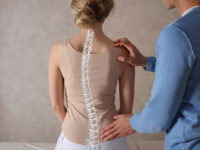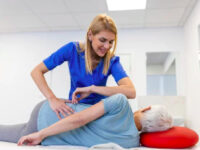Massage Is a Great Stress Reliever
You can get a massage from a professional therapist or do it yourself. Just be sure to find one with credentials properly licensed and insured in your area. Contact Massage Carlsbad today!
Some experts say massage interrupts the body’s pain loop by stimulating larger nerve fibers that block smaller ones from sending pain signals to the brain. This helps reduce cortisol and boost serotonin, which stabilizes mood.

Stress is a common condition that affects us all. It’s a natural reaction to life events that make us feel threatened or out of control. It can lead to headaches, backaches, and other aches and pains. There are many ways to relieve stress, such as yoga, vigorous exercise, and time spent outdoors. Massage is another great way to lower your stress levels. A study published in The Journal of Clinical Psychiatry suggests that getting a massage decreases anxiety by switching off the body’s “fight-or-flight” response and boosting the parasympathetic nervous system. This helps the body to relax and reduces feelings of anxiety, depression, and sadness. Massage also increases neurotransmitters, endorphins, serotonin, and dopamine, which help regulate mood and boost well-being.
In addition to decreasing stress, massage can also decrease pain. Stress can increase pain because it causes the muscles to tense up and limit movement, which can cause further tension and pain. Massage helps relieve stress by lowering the heart rate, increasing relaxation, and releasing feel-good hormones that help to reduce the intensity of pain signals sent to the brain.
Regular massages can also help to improve posture and increase flexibility. Tight muscles pull bones out of alignment, leading to poor posture and hurting our overall health. Massage increases the elasticity of muscle tissue and encourages a healthy range of motion to prevent further damage and pain.
If you plan on a massage, scheduling it when you can truly relax is important. It’s hard to enjoy your massage if you are running late, stressed out, and short of breath from a hectic day at work or have a full social calendar planned immediately afterward. Try to arrive at your appointment about 10 to 15 minutes early so you can complete any paperwork without affecting the massage.
If you aren’t sure whether massage is right for you, talk to your doctor about your concerns and ask for recommendations from a reputable massage therapist. However, remember that a massage shouldn’t replace other medical treatments necessary to treat an underlying health condition.
Massage has been shown to reduce pain by interrupting or overwhelming the nerves that report pain in injured tissue, called nociceptors. It also stimulates the release of feel-good hormones, endorphins, serotonin, and dopamine, which help alleviate stress, increase relaxation, decrease anxiety, and improve mood.
During massage techniques, the skin and fingers create friction, causing an increase in temperature within both the superficial layers of muscle tissues and the deeper layers of fascia (the tough layer of fibrous connective tissue that surrounds muscles). The increased temperature allows for increased blood flow, increasing the amount of oxygen and nutrients delivered to the painful areas. This process may also help break down adhesions (scar tissue) that commonly cause pain in the body.
This increases the blood flow and stretches and expands the muscles, helping to remove any movement restriction caused by injury or overuse. This can lead to an improved range of motion, which can reduce pain as the body does not have to compensate for a limited range of motion.
A traumatic injury or overuse of the muscles can cause muscle fibers to be damaged. This causes them to tighten around the affected area. This restriction of movement can then limit blood flow to the muscle, further exacerbating the pain. This pain cycle is often called the pain loop, as it can be difficult to break. A massage can help to break this cycle by breaking the inflammatory response, allowing the muscles to relax and restoring proper movement patterns.
In addition, massage can help to stimulate the opiate receptors in the brain, which sends signals to the body to reduce pain. It also strongly impacts the vasodilatory system, which helps dilate the blood vessels, ensuring a better supply of oxygen and nutrients to the tissue and flushing away metabolic waste such as carbon dioxide. It can also encourage healthy lymphatic system circulation, which is important for immune function.
In addition to its pain-relieving, stress-reducing, and somatic benefits, therapeutic massage increases the immune system’s ability to fight viruses. When the body is exposed to a virus or bacteria, it produces antibodies that attack and destroy the foreign substances—also known as toxins—before they can do any damage. These antibodies then alert the lymphatic system to eliminate the toxins so they don’t spread throughout the body.
Studies have shown that massage can help the body clear toxins through increased circulation and lymph fluid flow, which removes waste products from the cells. The effleurage (long strokes) and petrissage (short, kneading movements) used in Swedish massage stimulate the lymphatic system to increase its normal function.
When the lymphatic system works normally, it transports bacteria and toxins to the lymph nodes, which are destroyed and expelled from the body. Studies have found that when the lymphatic system isn’t functioning properly, it can reduce immunity. Research suggests that massage can stimulate the lymphatic system to prevent this and treat lymphatic congestion.
A study performed on HIV-positive men found that after a month of receiving massage, they had higher levels of the NK cells that comprise the immune system’s initial defenses against illness. They also showed an increase in serotonin, another immune system booster.
Other clinical studies have shown that regular massage reduces cortisol levels, a hormone known to suppress the immune system. Researchers have speculated that these cellular changes may be caused by the physical pressure exerted during massage. The type of massage may also be important. While finger-driven stroking has shown some positive effects, other studies have demonstrated that hand-delivered stroking produces the best results.
So, with cold and flu season in full swing, consider a massage to help keep your immune system strong by decreasing stress hormones, increasing circulation and lymph fluid flow, and stimulating the body’s natural NK cell activity. Remember that one massage isn’t cut; a regular massage schedule will help your immune system stay strong all year round.
Intense training can be very hard on muscles, and it is essential to maintain healthy muscles in order to maximize the benefits of your exercise regime. Injuries like muscle sprains and tears can be prevented with regular massage. This is because massage improves blood flow to the muscle tissues. This, in turn, means more oxygen and nutrients are available to the muscles. This allows the muscles to heal more quickly and reduces muscle soreness.
Knots or tight muscle fibers are released during the massage, and the muscles can relax. Tight muscles are often a result of stress or poor posture, which causes other muscles to overwork and fatigue. This can lead to other physical problems as well as mental issues. When the muscles are relaxed, they can work much more effectively and help with your posture.
Muscle tissue needs a lot of oxygen to function properly. During massage, the body increases the oxygen supply to the muscle cells, which reduces fatigue and also aids recovery after exercise or injury. Massage also stimulates the proliferation of satellite cells, which repair muscle damage and growth. This helps to improve the overall strength of the muscles, which can then enhance performance during a workout.
Another way massage can improve muscle health is by removing waste products. This is because massage encourages the body to circulate more fluids, bringing in more oxygen and nutrients and removing waste products from the muscles, such as toxins and metabolic wastes.





